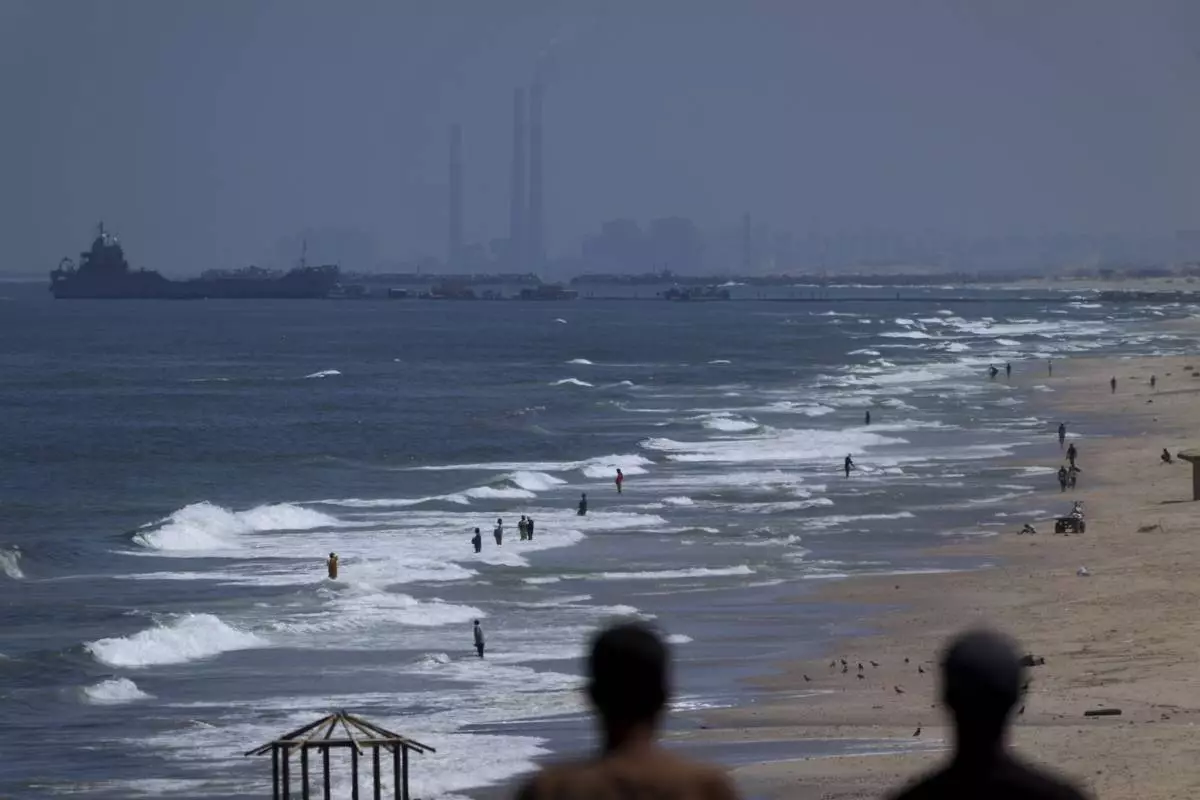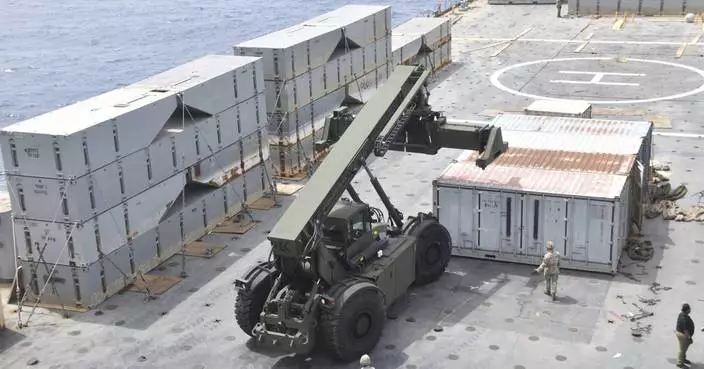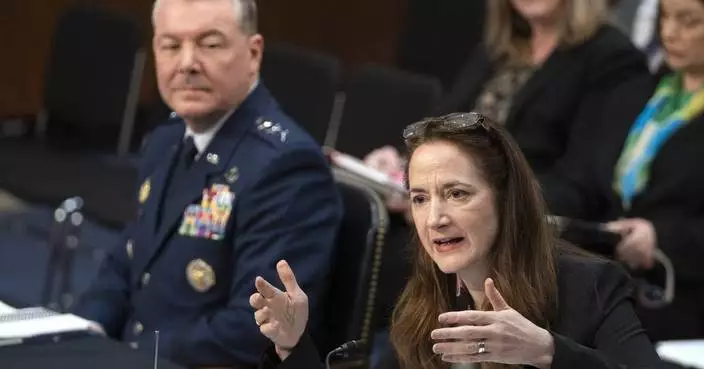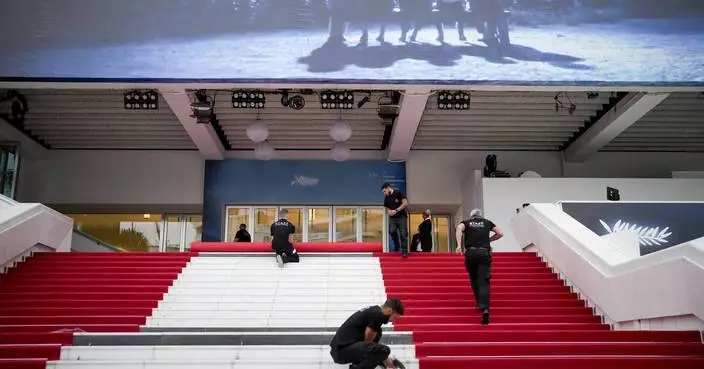The Trump administration is moving to reassign a political appointee at the Department of Housing and Urban Development to lead an internal watchdog agency at the Interior Department.
An email sent by HUD Secretary Ben Carson to staff says assistant HUD secretary Suzanne Israel Tufts will take over as acting inspector general at Interior. Tufts would replace Mary Kendall, who has served as acting inspector general since 2009.
An administration official told The Associated Press on Wednesday that Tufts won't start her job at Interior until required paperwork is completed. The official spoke on condition of anonymity because Tufts' appointment has not yet been publicly announced.

President Donald Trump listens during a cabinet meeting in the Cabinet Room of the White House, Wednesday, Oct. 17, 2018, in Washington. From left, Secretary of the Interior Ryan Zinke, Secretary of Transportation Elaine Chao, Trump, and Small Business Administration administrator Linda McMahon. (AP PhotoEvan Vucci)
Carson said in the email Friday that he had "mixed emotions" about Tufts' departure, calling her "an extremely enthusiastic and energetic leader who re-established (HUD's) Office of Administration, implementing improvements to the agency's governance and internal controls."
A spokeswoman for the inspector general's office said Kendall remains on the job. The agency "has received no official communication or information about any leadership changes," spokeswoman Nancy DiPaolo said Tuesday.
A spokeswoman for Interior Secretary Ryan Zinke said in a statement: "The position of the Inspector General has been vacant for about ten years. This is a presidentially appointed, Senate-confirmed position, which would be announced by the White House."
The spokeswoman, Faith Vander Voort, referred questions about Tufts to the White House, which did not immediately respond.
A HUD spokesman declined to comment.
It is unusual for a political appointee to be assigned to another agency, especially an inspector general's office. Kendall's oversees about 265 employees, including 80 investigators, who conduct a wide range of inquires at Interior, which oversees more than 245 million acres (380,000 square miles) of public lands, including 417 units in the national park system.
The change at the inspector general's office, if it occurs, comes as Zinke is under investigation on a number of fronts, including his involvement in a Montana land deal with the head of an energy services company that does business with the department. Zinke, a Republican, is a former Montana congressman.
The IG's office also is looking into the department's scuttling of a casino project in Connecticut proposed by the Mohegan and Mashantucket Pequot tribes. The decision, which overruled a staff recommendation, came after Zinke and other officials met with lobbyists for a competing group, MGM Resorts International.
Investigators are also probing how Zinke redrew boundaries of Utah's Grand Staircase-Escalante National Monument. The sprawling monument is one of two that President Donald Trump has shrunk to reverse what he calls overreach by Democratic presidents to protect federally controlled land.
Liz Hempowicz, director of public policy at the Project on Government Oversight, an independent government watchdog, called the move to install Tufts as acting inspector general "politically suspect."
The Trump administration "shouldn't be changing hats right now, when there are numerous investigations left to be completed," she said.
The AP obtained a copy of Carson's email, which was first reported by The Hill.
Associated Press writers Zeke Miller and Juliet Linderman contributed to this story.
WASHINGTON (AP) — A U.S.-built pier is in place to bring humanitarian aid to Gaza by sea, but no one will know if the new route will work until a steady stream of deliveries Begins reaching starving Palestinians.
The trucks that will roll off the pier project installed Thursday will face intensified fighting, Hamas threats to target any foreign forces who “occupy” the Gaza Strip and uncertainty about whether the Israeli military will ensure that aid convoys have access and safety from attack by Israeli forces.
Even if the sea route performs as hoped, U.S, U.N. and aid officials caution, it will bring in a fraction of the aid that's needed to the embattled enclave.
Here's a look at what's ahead for aid arriving by sea:
No, not even if everything with the sea route works perfectly, American and international officials say.
U.S. military officials hope to start with about 90 truckloads of aid a day through the sea route, growing quickly to about 150 trucks a day.
Samantha Power, head of the U.S. Agency for International Development, and other aid officials have consistently said Gaza needs deliveries of more than 500 truckloads a day — the prewar average — to help a population struggling without adequate food or clean water during seven months of war between Israel and Hamas.
Israel has restricted land crossings used to bring in food, fuel and other supplies since Hamas’ deadly attack on Israel launched the conflict in October, creating a growing humanitarian catastrophe for civilians.
International experts say all 2.3 million of Gaza's people are experiencing acute levels of food insecurity, 1.1 million of them at “catastrophic” levels. Power and U.N. World Food Program Director Cindy McCain say north Gaza is in famine.
At that stage, saving the lives of children and others most affected requires steady treatment in clinical settings, making a cease-fire critical, USAID officials say.
At full operation, international officials have said, aid from the sea route is expected to reach a half-million people. That's just over one-fifth of the population.
The U.S. plan is for the U.N. to take charge of the aid once it's brought in. Then U.N. World Food Program will then turn it over to aid groups for delivery.
U.N. officials have expressed concern about preserving their neutrality in an operation with the Israeli military — one of the combatants in the conflict — and say they are negotiating that.
There are still questions on how aid groups will safely operate in Gaza to distribute food to those who need it most, said Sonali Korde, assistant to the administrator for USAID's Bureau for Humanitarian Assistance, which is helping with logistics.
U.S. and international organizations including the U.S. government's USAID and the Oxfam, Save the Children and International Rescue Committee nonprofits say Israeli officials haven't meaningfully improved protections of aid workers since the military's April 1 attack that killed seven aid workers with the World Central Kitchen organization.
Talks with the Israeli military “need to get to a place where humanitarian aid workers feel safe and secure and able to operate safely. And I don’t think we’re there yet," Korde told reporters Thursday.
Meanwhile, fighting is surging in Gaza. It isn’t threatening the new shoreline aid distribution area, Pentagon officials say, but they have made it clear that security conditions could prompt a shutdown of the maritime route, even just temporarily.
The U.S. and Israel have developed a security plan for humanitarian groups coming to a “marshaling yard” next to the pier to pick up the aid, said U.S. Vice Admiral Brad Cooper, deputy commander of the U.S. military’s Central Command. USAID Response Director Dan Dieckhaus said aid groups would follow their own security procedures in distributing the supplies.
Meanwhile, Israeli forces have moved into the border crossing in the southern city of Rafah as part of their offensive, preventing aid from moving through, including fuel.
U.N. deputy spokesman Farhan Haq said that without fuel, delivery of all aid in Gaza can't happen.
U.S. President Joe Biden's administration, the U.N. and aid groups have pressed Israel to allow more aid through land crossings, saying that's the only way to ease the suffering of Gaza's civilians. They've also urged Israel's military to actively coordinate with aid groups to prevent attacks on their workers.
“Getting aid to people in need into and across Gaza cannot and should not depend on a floating dock far from where needs are most acute,” U.N. deputy spokesman Farhan Haq told reporters Thursday.
“To stave off the horrors of famine, we must use the fastest and most obvious route to reach the people of Gaza — and for that, we need access by land now,” Haq said.
U.S. officials agree that the pier is only a partial solution at best, and say they are pressing Israel for more.
Israel says it places no limits on the entry of humanitarian aid and blames the U.N. for delays in distributing goods entering Gaza. The U.N. says ongoing fighting, Israeli fire and chaotic security conditions have hindered delivery.
Under pressure from the U.S., Israel has in recent weeks opened a pair of crossings to deliver aid into hard-hit northern Gaza. It said a series of Hamas attacks on the main crossing, Kerem Shalom, have disrupted the flow of goods.
Associated Press writers Edith M. Lederer at the United Nations, Tara Copp in Washington and Josef Federman in Jerusalem contributed.

A ship is seen off the coast of Gaza near a U.S.-built floating pier that will be used to facilitate aid deliveries, as seen from the central Gaza Strip, Thursday, May 16, 2024. (AP Photo/Abdel Kareem Hana)

The image provided by U.S, Central Command, shows U.S. Army soldiers assigned to the 7th Transportation Brigade (Expeditionary), U.S. Navy sailors assigned to Amphibious Construction Battalion 1, and Israel Defense Forces placing the Trident Pier on the coast of Gaza Strip on Thursday, May 16, 2024. The temporary pier is part of the Joint Logistics Over-the-Shore capability. The U.S. military finished installing the floating pier on Thursday, with officials poised to begin ferrying badly needed humanitarian aid into the enclave besieged over seven months of intense fighting in the Israel-Hamas war. (U.S. Central Command via AP)












